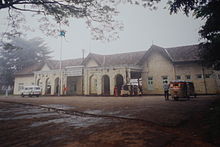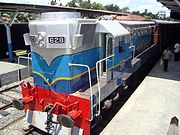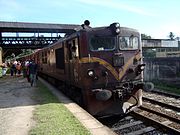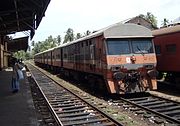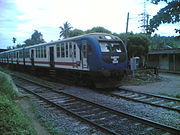- Sri Lanka Railways
-
This article is about the state-run railway operator. For general information on railways in Sri Lanka, see Rail transport in Sri Lanka.
Sri Lanka Railways 
Type Government-owned corporation Industry Rail transport Founded 1858 Headquarters Colombo, Sri Lanka Key people Mr. B.A.P.Ariyaratne,
General Manager (act.)Revenue - LKR 7,500,000,000 Employees approx.18000 Website www.railway.gov.lk Sri Lanka Railway Department, branded "Sri Lanka Railways", is a key department of the Sri Lankan Government under the Ministry of Transport with a history that begins in 1858. Sri Lanka Railways (formerly CGR – Ceylon Government Railway) operates the nation's rail network linking Colombo - the commercial capital of Sri Lanka - and many population centres and tourist destinations.
Contents
Overview
Presently the Sri Lankan Railway network consists of 1,508 kilometres with 5 ft 6 in (1,676 mm) broad gauge. The narrow gauge lines were 2 ft 6 in (762 mm). The railway contains some of the most magnificent scenic rail routes in the world. Particularly the Main Line winding through both natural beauties such as waterfalls, natural forest mountains, misty peaks and precipices, as well as man made festoons such as tea estates, pine forests and engineering feats including bridges and peak level stations.
History
Beginnings
The Railway Network was introduced by the British in 1864. The main reason for building a railway system in Sri Lanka (Ceylon) was to transport tea and coffee from the hill country to Colombo. Initially the service began with the Main Line of 54 kilometres connecting Colombo and Ambepussa.[1] Sir Guilford Lindsey Molesworth became the first chief engineer and later Director General of the government railways.
Extensions were made to the main line in 1867, 1874, 1885, 1894 and 1924, extending its service to Kandy, Nawalapitiya, Nanu Oya, Bandarawela and Badulla, respectively.[2] Many other railway lines were added to Ceylon Railway System within the first century of its life, such as a line to Matale in 1880, Coast Railway Line in 1895, Northern Line in 1905, Mannar Line in 1914, Kelani Valley in 1919, Puttalam Line in 1926, and Railway Line to Batticaloa and Trincomalee in 1928. For more than 80 years after that,[3] no more major extensions were added to the Sri Lankan (Ceylon) railway network as the British left the country for native rule.
Golden era
Though the British established the railway system, the golden era of Sri Lanka Railways was during 1955–1970 under the management of B.D Rampala, the most respected chief mechanical engineer and late General Manager of CGR. Rampala worked to maintain punctuality and improve comfort. He led the upgrading of major railway stations outside Colombo, and the rebuilding of the track in the Eastern Province to facilitate heavier and faster trains.[4]
Till 1953, Sri Lankan Railway served with steam locomotives. In the golden era, it enhanced its service to more power with diesel locomotives, under the leadership of Rampala.[4] Various types of diesel locomotives were added to the service.
Decline
In the late 20th century, the railway started to decline. For three decades, it suffered from neglect and poor treatment.[5]
Rebirth
In the early 2010s, the government launched a 10-year Railway Development Strategy to bring the railway back to satisfactory condition.[5] It started by ordering new diesel-multiple units(DMU) to replace the current trains.[5][6] The railway is upgrading the track on the Southern line, which was damaged in the 2004 tsunami,[7] and it is rebuilding the Northern line, which suffered from war for three decades.[8] The railway is also extending the Southern line from Matara to Kataragama, in order to serve the growing city of Hambantota.[3]
Routes
- Main Line – Colombo to Badulla.
- Matale Line from Peradeniya junction to Kandy and Matale.
- Udupussellawa Line (narrow gauge) from Nanu Oya junction to Ragala via Nuwara Eliya - Track abandoned in 1940.
- Coast Line– Colombo Secretariat halt to Matara via Galle - extension of the track up to Hambantota and Kataragama is currently under construction.
- Northern Line – Polgahawela to Kankesanturai deviates from the Main Line at Polgahawela junction - presently operating only up to Omanthai[9], track was abandoned beyond Vavuniya due to war but extended service up to Omanthei on May 2011 after the end of civil war. Reconstruction began in March 2009 to re-extend track up to Kankesanthurai.
- Mihintale Line from Anuradhapura to the sacred city of Mihintale.
- Batticaloa Line- separates from the Northern Line at Maho junction and extends up to Batticaloa via Polonnaruwa.
- Tricomalee Line- separates from the Batticaloaline at Gal-oya junction in the to Trincomalee.
- Puttalam Line – Colombo to Puttalam - deviates from the Main Line at Ragama.
- Industrial Line from Puttalam to Aruwakalu and Ilavankulam via Vanathavillu.
- Kelani Valley Line (originally narrow gauge) - Colombo to Yatiyantota - presently operating only up to Avissawella, the track beyond Avissawella was abandoned in 1940. Broad gauged up to Avissawella in 1997.
- Sabaragamuwa Line (Narrow Gauge) from Avissawella to Opanayaka via Ratnapura - Track abandoned in 1970.
- Mannar Line (Earlier Indo-Lanka Line) Medawachchi to Talaimannar - Divides from Northern Line at Medawachchi junction - damaged during the war, but rebuilding began in November 2010.[10]
Services
Sri Lanka Railways operates both intercity services, connecting major population centres, and commuter rail, serving Colombo commuter traffic.[11] The railways also transport freight.
Most inter-city services are provided in different classes of varying comfort[12]:
- 1st class sleeper carries sleeping-berths and are provided on a few overnight trains.
- 1st class observation car is available on certain daytime trains, mostly on the Main Line, and is very popular among tourists. The observation car provides wide views of the scenery and is normally at the rear of the train but occasionally behind the locomotive.
- 1st class air-conditioned[12] seats are only available on occasional inter-city express trains between Colombo and Vavunia and Colombo and Batticaloa.
- 2nd class seats are provided on all inter-city trains and are available as either unreserved seats or reserved seats, where a passenger is allocated a specific seat.
- 3rd class seats are available on most trains. This class can get very crowded and carries only basic facilities.
Commuter trains serve the busiest portions of the railways, ferrying commuters within Colombo and its suburbs.[13] Most commuter trains are operated with diesel-multiple units, and lack the three-class configuration seen in the inter-city services.[11] Commuter trains help alleviate rush hour congestion on city roads, but can be very crowded.
Electrification of the commuter rail network has been proposed, to improve energy efficiency and sustainability.[14]
Famous train names
Main article: List of named passenger trains of Sri LankaA number of long distance trains were named by CGR.
Regular services:
- Udarata Menike (Upcountry Maiden) - Runs between Colombo Fort and Badulla
- Podi Menike (Little Maiden) - Connects Colombo Fort and Badulla (no longer runs via Kandy, only through coaches to Kandy)
- Tikiri Menike (Little Maiden) - Colombo Fort to Hatton
- Senkadagala Menike (Maiden of “Senkadagala” – area name) - Runs between Colombo Fort and Kandy
- Yal Devi (Princess/Queen of Jaffna) - Was operated between Colombo Fort and Kankasanthurei via Jaffna (now only up to Thandikulam)[dated info]
- Udaya Devi (Princess/Queen of the Rise -East) - Runs between Colombo Fort and Batticaloa
- Rajarata Rajina (Queen of the land of kings) - Runs between Vavuniya and Matara via Colombo Fort
- Ruhunu Kumari (Princess of “Ruhuna” – southern province) - Between Colombo (Maradana) and Matara
- Samudra Devi (Queen of the Oceans) - Colombo (Maradana) to Galle[11]
- Galu Kumari (Princess of Galle) - Colombo (Maradana) to Matara
- Sagarika (Name of Ocean in Sinhala Language) - Colombo (Maradana) to Galle[15]
- Muthu Kumari (Princess of Pearls) - Operates between Panadura[citation needed] and Chilaw
Specials:
- Viceroy Special - Colombo to Kandy, Badulla, or Galle; by charter (Tourist excursion train powered by steam)[16]
- Bradby Express - Colombo to Kandy (for the Kandy leg of the annual Bradby Shield Encounter)[17]
Locomotives & Rolling Stock
Main article: Locomotives of Sri Lanka Railways Class M6 loco haul Udarata Menike Train from Badulla to Colombo
Class M6 loco haul Udarata Menike Train from Badulla to ColomboLocomotives of Sri Lanka Railways consist mostly of diesel locomotives. Steam locomotives were used on regular services until the 1950s, but now only run on heritage trains, such as the Viceroy Special.[18][4]
The first locomotives pulled trains in the 1860s on the original segment of the Main Line, on 54 kilometres connecting Colombo and Ambepussa.[19] In 1953, Sri Lanka Railways enhanced its service to more power with diesel locomotives.[4] Since then, various types of diesel locomotives were added to the service.
As of August 2011, Sri Lanka does not have commercially operational electric locomotives or train sets. Electrification has been proposed, to improve energy efficiency and sustainability.[20]
Most passenger coaches are either Romanian-built ASTRA passenger coaches[21][22] or Chinese-built CSR coaches. On most lines, the service is currently being upgraded, as new long-haul diesel multiple units from CSR and India's RITES Ltd are being imported.[23][24][25]
Issues
Finances
Like several state-owned enterprises in the country, Sri Lanka Railways regularly incurres large financial losses.[26] It has not made a profit since 1943. As of May 2007, the railway makes a revenue of about three billion rupees, but requires a state subsidy of seven billion rupees to balance its budget.[27]
It faces the challenge of addressing high operational and infrastructure costs, dealing with a Victorian era network. The State has been the employer of first resort, which has caused the railway to be overstaffed. Priority needs to be attached to reallocating labour from less to more productive employment activities.[28] The railway faces the need to rationalise underpriced fares.[29]
Infrastructure limitations
Sri Lanka Railways runs on Victorian-era infrastructure and aging equipment. A substantial amount of expenditure goes to rehabilitating poorly-maintained assets, as opposed to regular maintenance. Over the years, rolling stock capacity has declined due to this issue, reducing the quantity and quality that the system is able to provide.[26] Since 2007, the railways have been ordering new rolling stock to meet this shortage.[30]
Integration
Sri Lanka Railways has not integrated its services with other modes of transport. Unlike transport systems in some other countries, Sri Lanka does not streamline ticketing between road and rail passenger transport or provide thorough documentation for road/rail freight services. Buses do not provide dedicated feeder-bus services to the railways, resulting in Commuter rail and buses acting as isolated systems in relation to each other. This creates a loss in efficiency.[26]
Major accidents
- 18 March 1964 - A train derails at high speed, killing over 60 people near Mirigama.
- 19 January 1985 - LTTE bombed Yal Devi killing 11 civilians.
- 24 July 1996 - LTTE blasted an office train, resulted 70 civilian deaths at Dehiwala.
- 19 August 2001 - A train derails because of high speeds and over crowding, killing 46 between Alawwa and Rambukkana.
- January 2002 - The Intercity Express was heading to Colombo from Kandy derails near Rambukkana causing more than 15 deaths. The accident was due to malfunctioning of the braking system.
- 13 June 2002 – Train derails whilst coming into Alawwa station, killing 14 people.
- 26 December 2004 – Queen of the Sea train disaster, At Peraliya, approximately 2685 died in the world's biggest rail disaster as a train is overwhelmed by a Tsunami created by the 2004 Indian Ocean earthquake.
- 26 April 2005 – Polgahawela level crossing collision, a private bus tries to beat another bus and the train at a level crossing in Yangamodera close to Polgahawela crashed. 37 of commuters died, all on the bus.
- 17 September 2011 - Near Alawwa, two trains (an express and a Class S11 DMU) collide killing 3 persons and injuring 20 people[31]
Other than these, a number of accidents have taken place. One major type is elephant accidents, mainly in the North-Central area. Another common type of accidents occur at unsecured level crossings. There are only 527 secure level crossings in Sri Lanka out of 1684 crossings.
Gallery
Video
Some Video From Youtube about Sri Lanka Railway
- Sri Lanka Railway - S10 China Power Set on Kaluthara South - WithInside
- Sri Lanka Railway - S11 India Power Set on Kaluthara South
- Colombo Commuter Train - Mount Lavinia Railway Station, Sri Lanka Railway
- Sri Lanka Railway - S10 China Train Tour from Kaluthara South to Kaluthara North
- Kaluthara South Railway Station
Images
Several types of locomotives used by the Sri Lanka Railway Department for transporting passengers and wares:
Class M2 No.628 KankesanthuraiClass M4 MLW - Alco Bombardier LocomotiveHitachi M5c engineClass M6 locomotiveBrush DE- Class M7 LocomotiveHunslet Class Y shunting locomotiveKarl Marx Class W2 Diesel-hydraulic LocomotiveClass S8 Hyundai DMUIn popular culture
Sri Lanka Railways has become an integral part of local popular culture, with references to it in books and TV shows, as well as in everyday life.
Some of the most popular trains, such as the Samudra Devi, have become cultural symbols representing commuter travel as a part of suburban life. The railway impacts the way people perceive suburban living.[11]
See also
- Ceylon Railway Engineer Corps
- Rail transport in Sri Lanka
- Railway stations in Sri Lanka
- Transport in Sri Lanka
References
- ^ "Ceylon Railway Enthusiasts Circle (CREC)/SLRF". Sri Lanka Railway 145th Anniversary Trip. 2010-01-02. http://www.slrfc.org/2010/01/02/sri-lanka-railway-145th-anniversary-trip.
- ^ "Sunday Observer". Cameos of the past: First train on line to Badulla from Colombo. 2010-07-19. http://www.sundayobserver.lk/2009/02/01/foc13.asp.
- ^ a b "ColomboPage". Construction of Matara-Kataragama railway line in Southern Sri Lanka begins. 2010-04-06. http://www.colombopage.com/archive_10/Apr1270565856CH.php.
- ^ a b c d "The Island". Rampala regime in the local Railway History. 2010-07-19. http://www.island.lk/2008/07/23/features5.html.
- ^ a b c "Dailynews". Power sets to steam long distance travel. 2010-09-03. http://www.dailynews.lk/2010/09/02/news41.asp.
- ^ "Dailynews". Railway gets new power sets from China. 2010-04-23. http://www.dailynews.lk/2010/04/23/news30.asp.
- ^ "Sunday Observer". Complete overhaul for southern railway. 2009-11-01. http://www.slrfc.org/2009/11/01/complete-overhaul-for-southern-railway.
- ^ "Lanka Business Online". Sri Lanka gives northern rail rebuilding deal to India’s IRCON. 2010-08-18. http://www.slrfc.org/2010/08/18/sri-lanka-gives-northern-rail-rebuilding-deal-to-india.
- ^ "Sunday Observer". Yal Devi 'steams' into Omanthai. 2011-05-27. http://www.sundayobserver.lk/2011/05/29/new15.asp.
- ^ "Railway Gazette: Northern Railway revival funded". 2010-12-14. http://www.railwaygazette.com/nc/news/single-view/view/northern-railway-revival-funded.html. Retrieved 2010-12-14.
- ^ a b c d "The Island". Samudra Devi in a Tangle of Love!. 2009-07-12. http://www.slrfc.org/2009/07/12/samudra-devi-in-a-tangle-of-love.
- ^ a b "A beginner's guide to Train travel in Sri Lanka . . ."
- ^ "The Island". Railway Electrification: Let us Start, at least now. 2010-03-27. http://www.slrfc.org/2010/03/27/railway-electrification-let-us-start-at-least-now.
- ^ "Daily News". IESL proposes railway electrification project. 2010-12-25. http://www.dailynews.lk/2010/12/25/bus04.asp.
- ^ "Dailynews". Fifty Sagarika train passengers fined. 2010-10-14. http://www.dailynews.lk/2010/10/14/news050.asp.
- ^ Viceroy Vintage Train Tours
- ^ "The Bradby express". Sundaytimes.lk. http://sundaytimes.lk/100620/Sports/spt01.html. Retrieved 2010-09-07.
- ^ http://www.infolanka.com/org/mrail/locos1.html
- ^ "Ceylon Railway Enthusiasts Circle (CREC)/SLRF". Sri Lanka Railway 145th Anniversary Trip. 2010-01-02. http://www.slrfc.org/2010/01/02/sri-lanka-railway-145th-anniversary-trip.
- ^ "Daily News". IESL proposes railway electrification project. 2010-12-25. http://www.dailynews.lk/2010/12/25/bus04.asp.
- ^ "Daily News". Railway to buy more locos, carriages. 2007-05-12. http://www.dailynews.lk/2007/05/12/news03.asp.
- ^ http://www.infolanka.com/org/mrail/slrails.html The Railways of Sri Lanka (Ceylon)
- ^ "Dailynews". Railway gets new power sets from China. 2010-04-23. http://www.dailynews.lk/2010/04/23/news30.asp.
- ^ "ColomboPage". India hands over new power sets for Sri Lanka's Southern Railway Line. 2011-03-11. http://www.colombopage.com/archive_11/Mar11_1299787744CH.php.
- ^ "Dailynews". Power sets to steam long distance travel. 2010-09-03. http://www.dailynews.lk/2010/09/02/news41.asp.
- ^ a b c http://www.adb.org/Documents/Evaluation/CAPES/SRI/CAPE-SRI-Transport-Sector.pdf ADB Sector Paper. Sri Lanka Country Assistance Program Evaluation: Transport Sector. August 2007
- ^ "Lanka Business Online". Rolling Stock: Sri Lanka in 60 mln dlr train deal with China. 2007-05-11. http://www.lankabusinessonline.com/fullstory.php?newsID=1529015498&no_view=1&SEARCH_TERM=7.
- ^ "Daily FT". A new paradigm for providing economic services. 2011-08-03. http://www.ft.lk/2011/08/03/a-new-paradigm-for-providing-economic-services/.
- ^ "Asian Tribune". Sri Lanka’s Treasury cautions loss making state entities. 2011-06-01. http://www.asiantribune.com/news/2011/06/01/sri-lanka%E2%80%99s-treasury-cautions-loss-making-state-entities.
- ^ "China - Sri Lanka’s top lender in 2009". China - Sri Lanka’s top lender in 2009. 2010-04-18. http://www.sundayobserver.lk/2001/pix/PrintPage.asp?REF=/2010/04/18/fea01.asp.
- ^ "Daily Mirror". Power sets are of high quality: Railway Dept.. 2011-09-28. http://print.dailymirror.lk/news/news/57503.html.
External links
- Sri Lanka Railways Official Site
- Ministry of Transport
- Sri Lanka Railways Timetables
- Sri Lanka Railway mainland routes timetables from "Seat61" (this is not updated)
- Locomotives of the SRI LANKA RAILWAY (M2, Jaffna Rail pictures)
- Sri Lankan Diesel Locomotives Page
- BRUSH BAGNALL SRI LANKA Restoration web site
- Sri Lanka Railways Photo Collection
- Two Unforgettable Railway Accidents
- ෴අඟුරු නොකා වතුර නොබී කොළඹ දුවන යකඩ යකා෴
- Sri Lanka Railway Schedule - Mobile Edition
rail transport in Asia Sovereign
states- Afghanistan
- Armenia
- Azerbaijan
- Bahrain
- Bangladesh
- Bhutan
- Brunei
- Burma (Myanmar)
- Cambodia
- People's Republic of China
- Cyprus
- East Timor (Timor-Leste)
- Egypt
- Georgia
- India
- Indonesia
- Iran
- Iraq
- Israel
- Japan
- Jordan
- Kazakhstan
- North Korea
- South Korea
- Kuwait
- Kyrgyzstan
- Laos
- Lebanon
- Malaysia
- Maldives
- Mongolia
- Nepal
- Oman
- Pakistan
- Philippines
- Qatar
- Russia
- Saudi Arabia
- Singapore
- Sri Lanka
- Syria
- Tajikistan
- Thailand
- Turkey
- Turkmenistan
- United Arab Emirates
- Uzbekistan
- Vietnam
- Yemen
States with limited
recognition- Abkhazia
- Nagorno-Karabakh
- Northern Cyprus
- Palestine
- Republic of China (Taiwan)
- South Ossetia
Dependencies and
other territories- Christmas Island
- Cocos (Keeling) Islands
- Hong Kong
- Macau
Categories:- Rail transport in Sri Lanka
- Transport companies of Sri Lanka
- State owned commercial corporations of Sri Lanka
Wikimedia Foundation. 2010.




